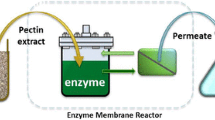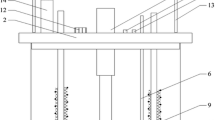Abstract
In this paper, a two-step resin adsorption technology was investigated for spinosad production and separation as follows: the first step resin addition into the fermentor at early cultivation period to decrease the timely product concentration in the broth; the second step of resin addition was used after fermentation to adsorb and extract the spinosad. Based on this, a two-step macroporous resin adsorption-membrane separation process for spinosad fermentation, separation, and purification was established. Spinosad concentration in 5-L fermentor increased by 14.45 % after adding 50 g/L macroporous at the beginning of fermentation. The established two-step macroporous resin adsorption-membrane separation process got the 95.43 % purity and 87 % yield for spinosad, which were both higher than that of the conventional crystallization of spinosad from aqueous phase that were 93.23 and 79.15 % separately. The two-step macroporous resin adsorption method has not only carried out the coupling of spinosad fermentation and separation but also increased spinosad productivity. In addition, the two-step macroporous resin adsorption-membrane separation process performs better in spinosad yield and purity.






Similar content being viewed by others
References
Kirst, H. A., Michel, K. H., Mynderase, J. S., Chio, E. H., Yao, R. C., Nakasukasa, W. M., Boeck, L., Occlowitz, J. L., Paschal, J. W. and Deeter, J. B., editors (1992). Discovery, isolation and structure elucidation of a family of structurally unique fermentation derived tetracyclic macrolides. ACS symposium series (USA).
Kirst, H. A. (2010). The spinosyn family of insecticides: realizing the potential of natural products research. The Journal of Antibiotics, 63, 101–111.
Hong, L., Zhao, Z., Melançon, C. E., Zhang, H., & Liu, H. W. (2008). In vitro characterization of the enzymes involved in TDP-D-forosamine biosynthesis in the spinosyn pathway of Saccharopolyspora spinosa. Journal of the American Chemical Society, 130, 4954–4967.
Waldron, C., Matsushima, P., Rosteck, P. R., Jr., Broughton, M. C., Turner, J., Madduri, K., Crawford, K. P., Merlo, D. J., & Baltz, R. H. (2001). Cloning and analysis of the spinosad biosynthetic gene cluster of Saccharopolyspora spinosa. Chemical Biology, 8, 487–499.
Kim, H. J., Ruszczycky, M. W., Choi, S. H., Liu, Y. N., & Liu, H. W. (2011). Enzyme-catalysed [4+ 2] cycloaddition is a key step in the biosynthesis of spinosyn A. Nature, 473, 109–112.
Kim, H. J., White-Phillip, J. A., Ogasawara, Y., Shin, N., Isiorho, E. A., & Liu, H. W. (2010). Biosynthesis of spinosyn in Saccharopolyspora spinosa: synthesis of permethylated rhamnose and characterization of the functions of SpnH, SpnI, and SpnK. Journal of the American Chemical Society, 132, 2901–2903.
Baltz, R. H. (2006). Molecular engineering approaches to peptide, polyketide and other antibiotics. Nature Biotechnology, 24, 1533–1540.
Xue, C. Y., Duan, Y. J., Zhao, F. L., & Lu, W. Y. (2013). Stepwise increase of spinosad production in Saccharopolyspora spinosa by metabolic engineering. Biochemical Engineering Journal, 72, 90–95.
Strobel, R. J., Jr., & Nakatsukasa, W. M. (1993). Response surface methods for optimizing Saccharopolyspora spinosa, a novel macrolide producer. Journal Industrial Microbiol & Biotechnol, 11(2), 121–127.
Luo, Y. S., Kou, X. X., Ding, X. Z., Hu, S. B., Tang, Y., Li, W. P., Huang, F., Yang, Q., Chen, H. N., & Xia, L. Q. (2012). Promotion of spinosad biosynthesis by chromosomal integration of the Vitreoscilla hemoglobin gene in Saccharopolyspora spinosa. Science China. Life Sciences, 55, 172–180.
Liang, Y., Lu, W. Y., & Wen, J. P. (2009). Improvement of Saccharopolyspora spinosa and the kinetic analysis for spinosad production. Applied Biochemistry and Biotechnology, 152, 440–448.
Li, J. A. and Han, L. M. (2012). Methord of spinosad crude extracting. CN Patent 101560231 B.
Baker, P. J. (1993). Process for isolatingA83543 and its components. US Patent 5227295 A.
Xia, L. Q., Ding, X. Z., Yu, Z. Q., Yang,W. and Wu, W. (2013). Process for extracting pleocidinfrom fermentation liquor of Saccharopolyspora spinosa. CN Patent 101906124.
Ferras, E., Minier, M., & Goma, G. (1986). Acetonobutylic fermentation: improvement of performances by coupling continuous fermentation and ultrafiltration. Biotechnology and Bioengineering, 28, 523–533.
Kwon, Y. J., Kaul, R., & Mattiasson, B. (1996). Extractive lactic acid fermentation in poly (ethyleneimine)-based aqueous two-phase system. Biotechnology and Bioengineering, 50, 280–290.
Zhong, Z., Xu, F., Cao, Y., Low, Z. X., Zhang, F. and Xing, W. (2014). Purifying condensed water with ceramic ultrafiltration membranes. Journal Chemical. Technology and Biotechnol
Liu, C., & Wu, X. (1998). Optimization of operation parameters in ultrafiltration process. Journal of Biotechnology, 66, 195–202.
Pérez-Silva, I., Rodríguez, J. A., Ramírez-Silva, M. T., & Páez-Hernández, M. E. (2012). Determination of oxytetracycline in milk samples by polymer inclusion membrane separation coupled to high performance liquid chromatography. Analytica Chimica Acta, 718, 42–46.
Lee, S. C., Lee, K. H., Hyun, G. H., & Lee, W. K. (1997). Continuous extraction of penicillin G by an emulsion liquid membrane in a countercurrent extraction column. Journal Membrane Science, 124, 43–51.
Xue, C. Y., Zhang, X. M., Yu, Z. H., Zhao, F. L., Wang, M. L., & Lu, W. Y. (2013). Up-regulated spinosad pathway coupling with the increased concentration of acetyl-CoA and malonyl-CoA contributed to the increase of spinosad in the presence of exogenous fatty acid. Biochemical Engineering Journal, 81, 47–53.
Benincasa, C., Perri, E., Iannotta, N., & Scalercio, S. (2011). LC/ESI–MS/MS method for the identification and quantification of spinosad residues in olive oils. Food Chemistry, 125, 1116–1120.
Hua, Z., Chen, J., Lun, S., & Wang, X. (2003). Influence of biosurfactants produced by Candida antarctica on surface properties of microorganism and biodegradation of n-alkanes. Water Research, 37, 4143–4150.
Ahimou, F., Jacques, P., & Deleu, M. (2000). Surfactin and iturin A effects on Bacillus subtilis surface hydrophobicity. Enzyme and Microbial Technology, 27, 749–754.
Liu, J., Yuan, X., Zeng, G., Shi, J., & Chen, S. (2006). Effect of biosurfactant on cellulase and xylanase production by Trichoderma viride in solid substrate fermentation. Process Biochemistry, 41, 2347–2351.
Ebune, A., Al-Asheh, S., & Duvnjak, Z. (1995). Effects of phosphate, surfactants and glucose on phytase production and hydrolysis of phytic acid in canola meal by Aspergillus ficuum during solid-state fermentation. Bioresource Technology, 54, 241–247.
Ohta, K., & Hayashida, S. (1983). Role of Tween 80 and monoolein in a lipid-sterol-protein complex which enhances ethanol tolerance of sake yeasts. Applied and Environmental Microbiology, 46, 821–825.
Ghosh, R., Wan, Y., Cui, Z., & Hale, G. (2003). Parameter scanning ultrafiltration: rapid optimisation of protein separation. Biotechnology and Bioengineering, 81, 673–682.
Yu, S. C., Gao, C. J., Su, H. X., & Liu, M. H. (2001). Nanofiltration used for desalination and concentration in dye production. Desalination, 140, 97–100.
Hassani, A. H., Mirzayee, R., Nasseri, S., Borghei, M., Gholami, M., & Torabifar, B. (2008). Nanofiltration process on dye removal from simulated textile wastewater. International Journal of Environmental Science and Technology, 5, 401–408.
Cleveland, C. B., Bormett, G. A., Saunders, D. G., Powers, F. L., McGibbon, A. S., Reeves, G. L., Rutherford, L., & Balcer, J. L. (2002). Environmental fate of spinosad. 1. Dissipation and degradation in aqueous systems. Journal of Agricultural and Food Chemistry, 50, 3244–3256.
Hu, X. Z. (2005). Study on the isolation and purification of spinosad. Hubei, CN: MA thesis, Huazhong Agricultural University.
Qin, W. H. (2010). Research on extraction and purification of spinosad. Wuhan, CN: MA thesis, Wuhan University of Technology.
Lu, L., Li, J. A. and Han, L. M. (2011). Methord for spinosad fermentation liquid pigment removal. CN Patents 101659685 B.
Baker, P. J. (1991). A83543 recovery process. WO Patent 1991006552 A1
Xia, C. Y., Wang, C., Wu, J. L., Zou, Q. L., Li, C., & Zhang, X. L. (2014). Study on the isolation and purification of spinosa. Journal of the Chinese Cereals and Oils Association, 29, 95–101.
Acknowledgments
This work was supported by the Natural Science Foundation of China (Nos. 21076148 and 31270087) and the Plan for Tianjin Science and Technology Support (No 11ZCKFSY0100).
Compliance with Ethical Standards
ᅟ
Conflict of Interest
The authors declare that they have no conflict of interest.
Author information
Authors and Affiliations
Corresponding author
Additional information
Fanglong Zhao and Chuanbo Zhang contributed equally to this work.
Rights and permissions
About this article
Cite this article
Zhao, F., Zhang, C., Yin, J. et al. Coupling of Spinosad Fermentation and Separation Process via Two-Step Macroporous Resin Adsorption Method. Appl Biochem Biotechnol 176, 2144–2156 (2015). https://doi.org/10.1007/s12010-015-1704-1
Received:
Accepted:
Published:
Issue Date:
DOI: https://doi.org/10.1007/s12010-015-1704-1




